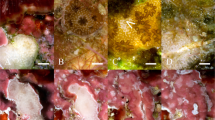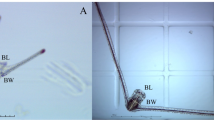Abstract
The development of standardized and sustainable aquaculture techniques for the cultivation of marine organisms offers many advantages: it would help reduce the quantity of living material harvested from coral reefs; it could be used as an efficient means of rehabilitating impoverished reef ecosystems (e.g. by reseeding depleted natural stocks of corals); it would provide an educational and research tool for the intensive study of marine animal biology under controlled laboratory conditions.
Here, we present the results of aquarium maintenance of 3 Red Sea soft coral species (Clavularia hamra, Nephthea sp., Litophyton arboreum) raised from field collected larvae. Planulae settlement was enhanced when dead coral fragments and stones freshly collected from the sea were added to the settlement dishes. Young colonies (n=106, 258, 60; respectively) were monitored for 307, 475 and 207 days, respectively. The survival rate at the end of the observations ranged between 17% and 30%. Growth rates of colonies differed and showed species-specific variations. The most successful growth was recorded in Nephthea where the average colony size reached 324.5 polyps. Current aquaculture techniques for alcyonarian corals not only reveal that these organisms can thrive in aquaria but also provide significantly improved yields of colonies, as compared with yields under field conditions. Our studies have shown that various steps involved in the cultivation of young corals in captivity may need to be specifically tailored to suit the coral species in question.
Similar content being viewed by others
REFERENCES
Adey, W.H. and Loveland, K. (1991) Dynamic Aquaria. Building Living Ecosystems. San Diego: Academic Press, 643 pp.
Alino, P.M. and Coll, J.C. (1989) Observations of the synchronized mass spawning and post settlement activity of octocorals on the Great Barrier Reef, Australia: biological aspects. Bulletin of Marine Science 45, 697–707.
Barki, Y. (1999) Aspects in the development, allorecognition responses and genetics in Red Sea soft corals. Ph. D. Dissertation, Tel Aviv University (Hebrew with English summary), 97 pp.
Benayahu, Y. (1989) Reproductive cycle and developmental processes during embryogenesis of Clavularia hamra (Cnidaria, Octocorallia). Acta Zoologica (Stockholm) 70, 29–36.
Ben-David-Zaslow, R. (1994) Longevity and competency of planulae of Octocorallia. M.Sc. Thesis, Tel Aviv University (Hebrew with English summary), 67 pp.
Ben-David-Zaslow, R. and Benayahu, Y. (1998) Competence and longevity in planulae of several species of soft corals. Marine Ecology Progress Series 163, 235–243.
Best, M.B. (1997) Trade in corals and living stones. Proceedings of the 6th International Conference on Coelenterate Biology, pp. 47–52.
Delbeek, J.C. and Sprung, J. (1994) The Reef Aquarium. Coconut Grove, Florida: Ricordea Publishing, Vol. 1, 544 pp.
Emschermann, P. (1987) A circulating water tank for culturing sessile or hemisessile aquatic organisms in a continuous water current. Archives in Hydrobiology 108, 425–438.
Evans, K.L. (1997) Aquaria and marine environmental education. Aquarium Sciences and Conservation 1, 239–250.
Farrant, P.A. (1987) Population dynamics of the temperate Australian soft coral Capnella gaboensis. Marine Biology 96, 401–407.
Gateño, D., Israel, A., Barki, Y. and Rinkevich, B. (1998) Gastrovascular circulation in an octocoral: Evidence of significant transport of coral and symbiont cells. Biological Bulletin 194, 178–186.
Helsinga, G.A. (1996) Sustainable aquaculture in the marine aquarium industry. Proceedings of the Pacon Conference on Sustainable Aquaculture, p. 174.
Kinne, O. (1977) Cultivation of animals. In: Marine Ecology. Vol. III. Cultivation, (O. Kinne, ed.) Part 2, New York: John Wiley & Sons, pp. 579–668.
Mamonov, G.A. (1980) Aquarium hobby and nature conservation. Przeglad Zoologiczny 24, 241–247.
Maroz, A. and Fishelson, L. (1997) Juvenile production of Amphiprion bicinctus (Pomacentridae, Telostei) and rehabilitation of impoverished habitats. Marine Ecology Progress Series 151, 295–297.
Rinkevich, B. and Shapira, M. (1998) Animproved diet for inland broodstock and the establishment of an inbred line from Botryllus schlosseri, a colonial sea squirt (Ascidiacea). Aquatic Living Resources 11, 163–171.
Ritchie, R.J., Eltringham, K., Salih, A., Grant, A.J., Withers, K.J.T. and Hinde, R. (1997) Plesiastrea versipora (Lamarck, 1816). The white rat for coral research? Proceedings of the 6th International Conference on Coelenterate Biology, pp. 403–408.
Sadovy, Y. (1992) A preliminary assessment of the marine aquarium export trade in Puerto Rico. Proceedings of the 7th International Conference on Reef Symposium, Guam, Vol. 2, pp. 1014–1022.
Sprung, J. and Delbeek, J.C. (1997) The Reef Aquarium. Coconut Grove, Florida: Ricordea Publishing, Vol. 2, 546 pp.
Sykes, G.R. (1997) Coral aquaculture. An alternative to coral reef harvests. Aquarist and Pondkeeper 61, 6–9.
Weil, D. (1990) Life history of the Alcyonacean Litophyton arboreum in the Gulf of Eilat: sexual and asexual reproduction. M. Sc. Thesis, Department of Zoology, Tel Aviv University (Hebrew with English summary), 142 pp.
Wells, S.M. and Alcala, A.C. (1987) Collecting of corals and shell. In: Human Impacts on Coral Reefs: Facts and Recommendations. (B. Salvat, ed.) French Polynesia: Antenne Museum E.P.H.E., pp. 13–27.
Author information
Authors and Affiliations
Rights and permissions
About this article
Cite this article
Gateño, D., Barki, Y. & Rinkevich, B. Aquarium Maintenance of Reef Octocorals Raised from Field Collected Larvae. Aquarium Sciences and Conservation 2, 227–236 (2000). https://doi.org/10.1023/A:1009627313037
Issue Date:
DOI: https://doi.org/10.1023/A:1009627313037




